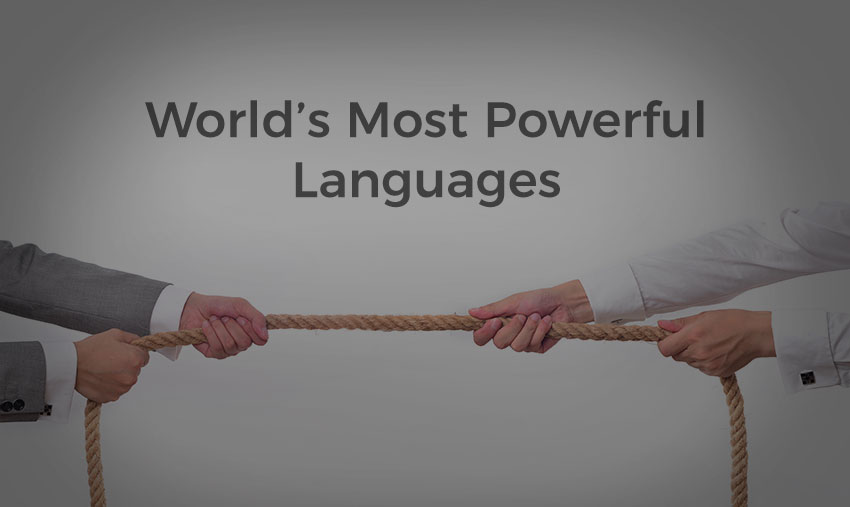“To have another language is to possess a second soul.” This famous quote by Charlemagne is especially significant in an increasingly globalized world, where functionality in multiple languages may be considered as the passport of a true global citizen. Therefore in a world with over 6000 spoken dialects, what languages would be the most useful to maximize communication? The following is a list of the top 10 most powerful languages compiled by Kai L. Chan (PhD) using the Power Language Index (PLI). The PLI compares the efficiency of more than a hundred of the top spoken languages by using 20 indicators (GDP/capita, tourist flow, etc.) and considers five opportunities that these indicators provide – geography, economy, communication, knowledge and media, and diplomacy. The overall score of each language ranges from 0 (least powerful) to 1 (most powerful).
English
With a PLI score of 0.889, English remains the world’s lingua franca with Mandarin following as a distant runner up. Previous colonization and continued globalization has led to the establishment of English as lingua franca, and it now serves as the main language of global trade, business, and cultural interactions. It is the dominant language of three G7 nations (USA, UK and Canada).
Mandarin
Although China’s economic might and influence continue to grow, it scores at less than half the value of English at 0.411. However, English is expected to remain ahead by a considerably smaller margin than Mandarin by 2050. Spoken by almost 70% of the Chinese population, with celebrities such as Mark Zuckerberg embracing the dialect, Mandarin is a fast-growing language that could have the potential of challenging the supremacy of English.
French
Strong results in geography and diplomacy keep French as the third most powerful language with 0.337 points. A Romance language of the Indo-European family, French is spoken by an estimated 80 million native speakers worldwide and is the official language in 29 countries. It is also the 4th most widely spoken mother tongue of the European Union.
Spanish
Also a Romance language, Spanish is spoken by a staggering 470 million native speakers worldwide, a huge ways ahead of the French-speaking population. It is the official language in 20 countries, mostly in the Americas and Spain and is also one of the six official languages of the United Nations. Spanish is also an official language of the European Union.
Arabic
An Afro-Asiatic language, first emerging during the Iron Age in northwestern Arabia, Arabic is now the lingua franca of the modern Arab world. With approximately 290 million native speakers alone, Arabic additionally forms the sacred language of 1.7 billion Muslims and is also one of the six official languages of the United Nations.
Russian
As the official language in over 38 territories, Russian is the most geographically widespread language of Eurasia. With 144 million native speakers, the Russian language is the largest native language in Europe along with being the most popular of the Slavic languages. After English, Russian is considered to be the most prevalent language of the internet and is also one of two official languages aboard the International Space Station. (Psst- I’ve got some facts here about Russian, I bet you’ll enjoy them)
German
In addition to being the lingua franca of Central and Eastern Europe, German is a language that is fast gaining popularity on the internet. Like English, German is a pluricentric language; it has a range of dialects and unique varieties that exist in different regions. German-speaking countries are also ranked 5t in terms of annual publication of new books, with 18% of the world’s books published in the language.
Japanese
The tongue of an economic heavyweight, Japanese currently makes up the internet’s 3rd largest language group behind English and Russian. Although little is known about the language’s prehistory, Japanese is spoken natively by over 125 million individuals worldwide. Japanese extensively uses Chinese characters (kanji) despite the lack of linguistic relationship between both languages, offering a gateway to other Asian languages and cultures.
Portuguese
With nearly 215 million native speakers, Portuguese is the most commonly spoken language in South America and an official language of the European Union. As a result of colonization, a cultural presence of Portuguese and Portuguese creole speakers are also found in India, Batticaloa on the east coast of Sri Lanka, in the Indonesian island of Flores and in Malacca of Malaysia.
Hindi
Modern Standard Hindi, a Sanskritised register of the Hindustani language, is one of the most common tongues in the world with approximately 310 million individuals speaking the language worldwide. In fact, if Hindi, Urdu, and all its dialects were included for the PLI, it would stand at the 8th position, ahead of Japanese and Portuguese. Hindi is considered the lingua franca in the so-called Hindi belt region in India.
Now you know the powerhouses of linguistic money makers. What power language do you want to learn?
Andrie Steliou
Latest posts by Andrie Steliou (see all)
- 8 Ways to Help Keep Your Child Focused and Engaged in Online Learning - October 19, 2022
- How to Improve Social Intelligence Skills? - May 10, 2022
- How to Improve Organizational Skills at Workplace? - May 6, 2022



